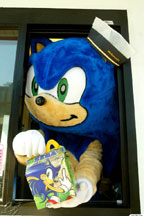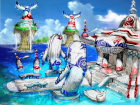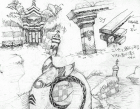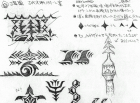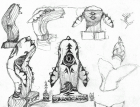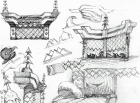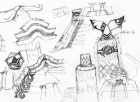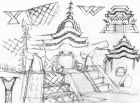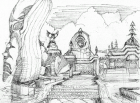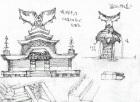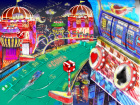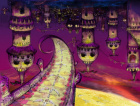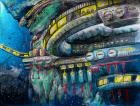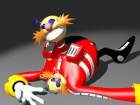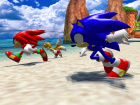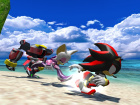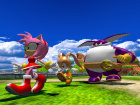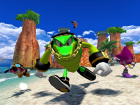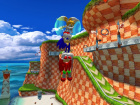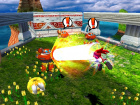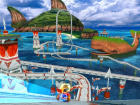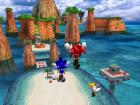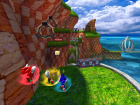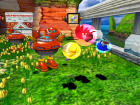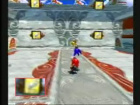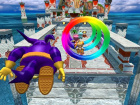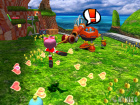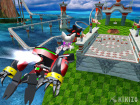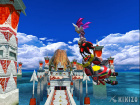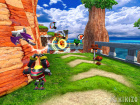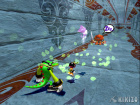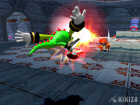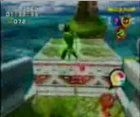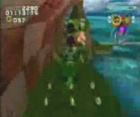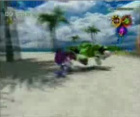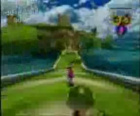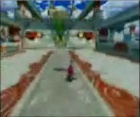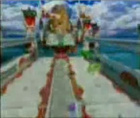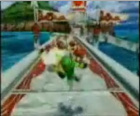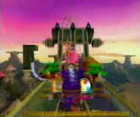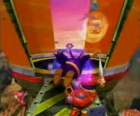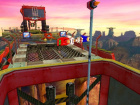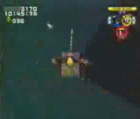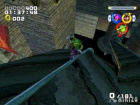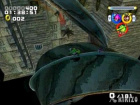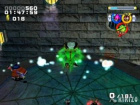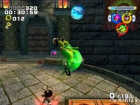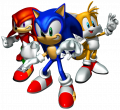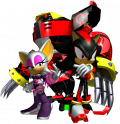Difference between revisions of "Sonic Heroes/Development"
From Sonic Retro
(→Seaside Hill) |
Levi Church (talk | contribs) |
||
| (8 intermediate revisions by 4 users not shown) | |||
| Line 1: | Line 1: | ||
| + | {{back}}[[Category:Development]] | ||
| + | {{cleanup|*There are not enough references to back up claims}} | ||
''[[Sonic Heroes]]'' went through many ideas and changes during the development process. What follows is a collection of items related to the game's development. | ''[[Sonic Heroes]]'' went through many ideas and changes during the development process. What follows is a collection of items related to the game's development. | ||
| Line 9: | Line 11: | ||
Not just using the main cast of the two ''Adventure'' titles, it was decided that three of the [[Chaotix (characters)|Chaotix]] - [[Espio the Chameleon]], [[Vector the Crocodile]] and [[Charmy Bee]] - would be resurrected for production of the game. Redesigned just as the classic cast had been to fit into the modern style by [[Yuji Uekawa]], Iizuka decided to treat the Chaotix as if they were new characters, ignoring certain traits that had been established in the Japanese ''Chaotix'' manual that would have contradicted their intent in the game. Additionally, two new characters were created specifically for ''Heroes'', those being [[E-123 Omega]] (a clear homage to [[E-102 Gamma]] who could not return due to story reasons) and [[Cream the Rabbit]]. Though drawn up for the game, the team felt that it would be better to first introduce the young rabbit girl and her pet Chao [[Cheese]] in the [[sega:Game Boy Advance|Game Boy Advance]] title ''[[Sonic Advance 2]]''. Establishing her in the hand held title, it was done for two reasons, the first to make players familiar with her, the second to help make the handheld sequel feel fresh in comparison to its predecessor. The flying rabbit was also featured in a cameo in ''Sonic Adventure DX'' for similar reasons. | Not just using the main cast of the two ''Adventure'' titles, it was decided that three of the [[Chaotix (characters)|Chaotix]] - [[Espio the Chameleon]], [[Vector the Crocodile]] and [[Charmy Bee]] - would be resurrected for production of the game. Redesigned just as the classic cast had been to fit into the modern style by [[Yuji Uekawa]], Iizuka decided to treat the Chaotix as if they were new characters, ignoring certain traits that had been established in the Japanese ''Chaotix'' manual that would have contradicted their intent in the game. Additionally, two new characters were created specifically for ''Heroes'', those being [[E-123 Omega]] (a clear homage to [[E-102 Gamma]] who could not return due to story reasons) and [[Cream the Rabbit]]. Though drawn up for the game, the team felt that it would be better to first introduce the young rabbit girl and her pet Chao [[Cheese]] in the [[sega:Game Boy Advance|Game Boy Advance]] title ''[[Sonic Advance 2]]''. Establishing her in the hand held title, it was done for two reasons, the first to make players familiar with her, the second to help make the handheld sequel feel fresh in comparison to its predecessor. The flying rabbit was also featured in a cameo in ''Sonic Adventure DX'' for similar reasons. | ||
| − | One character that was | + | One character that was originally intended to be playable was the fan-favorite villain [[Metal Sonic]].{{ref|https://archive.ph/3ztgk#selection-3551.0-3551.130|https://twitter.com/mizuhano/status/989669646730067968}} Listening to fan demand that wanted to see the return of the mechanical menace, the team enlisted the original designer of the character, [[Kazuyuki Hoshino]], to help with the redesign. Having been a part of Sonic Team for quite a while (including the Art Director for both ''Adventure'' titles) it only made sense for him to be involved in the reintroduction of one of his most successful characters. Though the redesign was in some ways drastic, and was teased in nearly every promotional trailer, the look was only briefly glanced at in-game. |
| − | Instead of restricting the game to just one platform, the development team wanted to have separate releases for all three major gaming consoles at the time, and the PC. In order to do this, Sega acquired the rights to use the [[ | + | The original cast of characters intended for the game are Sonic, Tales, Knuckles, Amy, Cream, Rouge, [[Chaos]], [[E-102 γ]], Big, Espio, Charmy, Vector, [[Fang the Sniper|Fang]], [[Bean the Dynamite|Bean]] [[Bark the Polar Bear|Bark]], Metal Sonic, [[Ray the Flying Squirrel|Ray]] and [[Mighty the Armadillo|Mighty]].{{ref|https://archive.ph/3ztgk#selection-3551.0-3551.130|https://twitter.com/mizuhano/status/989669646730067968}} |
| + | |||
| + | Instead of restricting the game to just one platform, the development team wanted to have separate releases for all three major gaming consoles at the time, and the PC. In order to do this, Sega acquired the rights to use the [[sega:RenderWare|RenderWare]] engine, a middleware platform for graphics rendering. Even with this additional work, the process of porting the game to the [[sega:PlayStation 2|PlayStation 2]] and the [[sega:Xbox|Xbox]] proved more difficult than first anticipated, due to the team's unfamiliarity with consoles. Possibly as a result, the PlayStation 2 version became the least optimised version of the game, suffering from clipping and graphical faults as well as a lower framerate, making it the least well-received of the ports. | ||
In order to hype up the release and reaffirm Sonic's status in the gaming world, the year of 2003 was called "The Year of Sonic" in numerous interviews across the board. With the premier of the animated series ''[[Sonic X]]'', the first [[McDonald's Sonic LCD games|McDonald's Happy Meal tie-in]] in nearly a decade, and the release of multiple Sonic-related titles (including the port of ''Sonic Adventure'' and the Game Boy titles ''[[Sonic Pinball Party]]'' and ''[[Sonic Battle]]'') the character of [[Sonic the Hedgehog]] was pushed in all corners, something that hadn't been done since the original release of ''Adventure''. To add to the excitement of the new release, a [[Sonic Heroes (Mario Kart: Double Dash!! Bonus Disc)|demo of the game]] was included with some early copies of ''Mario Kart: Double Dash'', hyping the console the game was first developed on. However, ''Sonic Heroes'' was only released in Japan that year on December 30th, not seeing western shores until February of 2004 and missing the coveted holiday push altogether, an unforeseen delay in production being the cause. | In order to hype up the release and reaffirm Sonic's status in the gaming world, the year of 2003 was called "The Year of Sonic" in numerous interviews across the board. With the premier of the animated series ''[[Sonic X]]'', the first [[McDonald's Sonic LCD games|McDonald's Happy Meal tie-in]] in nearly a decade, and the release of multiple Sonic-related titles (including the port of ''Sonic Adventure'' and the Game Boy titles ''[[Sonic Pinball Party]]'' and ''[[Sonic Battle]]'') the character of [[Sonic the Hedgehog]] was pushed in all corners, something that hadn't been done since the original release of ''Adventure''. To add to the excitement of the new release, a [[Sonic Heroes (Mario Kart: Double Dash!! Bonus Disc)|demo of the game]] was included with some early copies of ''Mario Kart: Double Dash'', hyping the console the game was first developed on. However, ''Sonic Heroes'' was only released in Japan that year on December 30th, not seeing western shores until February of 2004 and missing the coveted holiday push altogether, an unforeseen delay in production being the cause. | ||
| − | + | ==Concept art== | |
| − | + | ===Character art=== | |
| − | |||
| − | |||
| − | |||
| − | |||
| − | |||
| − | |||
| − | ==Concept | ||
| − | |||
| − | ===Character | ||
<gallery> | <gallery> | ||
File:SH_SonicTrio_Concept.png | File:SH_SonicTrio_Concept.png | ||
| Line 35: | Line 30: | ||
</gallery> | </gallery> | ||
| − | ===Level | + | ===Level concept art=== |
<gallery widths="140px" heights="140px" > | <gallery widths="140px" heights="140px" > | ||
| − | File:SG_Conceptart_SSHZ5.png|Concept art for [[Seaside Hill]]. | + | File:SG_Conceptart_SSHZ5.png|Concept art for [[Seaside Hill (Sonic Heroes)|Seaside Hill]]. |
File:Heroes-sh_e3_art_stg01.png|Concept art for Seaside Hill. | File:Heroes-sh_e3_art_stg01.png|Concept art for Seaside Hill. | ||
File:SG_Conceptart_SSHZ1.png|Concept art for Seaside Hill. | File:SG_Conceptart_SSHZ1.png|Concept art for Seaside Hill. | ||
| Line 49: | Line 44: | ||
File:SG_Conceptart_SSHZ10.png|Concept art for Seaside Hill. | File:SG_Conceptart_SSHZ10.png|Concept art for Seaside Hill. | ||
File:SG_Conceptart_SSHZ11.png|Concept art for Seaside Hill. | File:SG_Conceptart_SSHZ11.png|Concept art for Seaside Hill. | ||
| + | File:SonicHeroes_ConceptArt_OceanPalace.jpg| Concept Art for [[Ocean Palace]]. | ||
File:Sonicheroes_level_concept_CasinoPark.jpg|Concept art for [[Casino Park]]. | File:Sonicheroes_level_concept_CasinoPark.jpg|Concept art for [[Casino Park]]. | ||
| − | File: | + | File:Sonicheroes_level_concept_BulletStation.jpg|Concept art for [[Rail Canyon]]. |
| + | File:Sonicheroes_level_concept_RailCanyon.jpg|Concept art for [[Bullet Station]]. | ||
File:Sonicheroes_level_concept_FrogForest.jpg|Concept art for [[Frog Forest]]. | File:Sonicheroes_level_concept_FrogForest.jpg|Concept art for [[Frog Forest]]. | ||
| + | File:Sonicheroes_level_concept_FrogForest2.jpg|Concept art for Frog Forest. | ||
| + | File:SonicHeroes_ConceptArt_LostJungle.jpg|Concept art for [[Lost Jungle]]. | ||
| + | File:SonicHeroes_ConceptArt_LostJungle2.jpg|Concept art for Lost Jungle. | ||
File:Sonicheroes_level_concept_HangCastle.jpg|Concept art for [[Hang Castle]]. | File:Sonicheroes_level_concept_HangCastle.jpg|Concept art for [[Hang Castle]]. | ||
File:Sonicheroes_level_concept_EggFleet.jpg|Concept art for [[Egg Fleet]]. | File:Sonicheroes_level_concept_EggFleet.jpg|Concept art for [[Egg Fleet]]. | ||
| − | File:Sonicheroes_level_concept_FinalFortress.jpg | + | File:Sonicheroes_level_concept_FinalFortress.jpg|Concept art for [[Final Fortress]]. |
| + | File:SonicHeroes_ConceptArt_Unknown.jpg|Concept art for a scrapped pirate themed level. | ||
| + | File:SonicHeroes_ConceptArt_Unknown2.jpg|Concept art for a scrapped ruins level. The level draws inspiration from Japanese earthenware items and metalwork such as [//en.wikipedia.org/Dogū Dogū], [//en.wikipedia.org/Haniwa Haniwa], and [//en.wikipedia.org/Dōtaku Dōtaku]. | ||
</gallery> | </gallery> | ||
| Line 87: | Line 89: | ||
File:Intro_concept_heroes_25.png | File:Intro_concept_heroes_25.png | ||
</gallery> | </gallery> | ||
| − | ====Team Dark | + | ====Team Dark intro==== |
By [[Shiro Maekawa]]. | By [[Shiro Maekawa]]. | ||
<gallery> | <gallery> | ||
| Line 103: | Line 105: | ||
</gallery> | </gallery> | ||
| − | ===3D | + | ===3D renders=== |
Taken from [http://www.vision-scape.com Vision-Scape]. | Taken from [http://www.vision-scape.com Vision-Scape]. | ||
<gallery widths="140px" heights="140px" > | <gallery widths="140px" heights="140px" > | ||
| Line 118: | Line 120: | ||
</gallery> | </gallery> | ||
| − | ==Promotional | + | ==Promotional screenshots== |
===Cutscenes=== | ===Cutscenes=== | ||
<gallery widths="140px" heights="140px" > | <gallery widths="140px" heights="140px" > | ||
| Line 190: | Line 192: | ||
*[[Unreleased Music#Sonic Heroes|Unreleased Music]] - A collection of early and unused music connected to ''Sonic Heroes''. | *[[Unreleased Music#Sonic Heroes|Unreleased Music]] - A collection of early and unused music connected to ''Sonic Heroes''. | ||
| − | ==External | + | ==External links== |
*[http://www.youtube.com/watch?v=Xddu4wUWUhE ''Sonic Heroes'' Opening (In Production)] - A version of the opening using early animation and storyboards. From ''[[Sonic Mega Collection Plus]]''. | *[http://www.youtube.com/watch?v=Xddu4wUWUhE ''Sonic Heroes'' Opening (In Production)] - A version of the opening using early animation and storyboards. From ''[[Sonic Mega Collection Plus]]''. | ||
*[http://www.youtube.com/watch?v=b63e5tmnZRo Intro Movie for Team Dark (In Production)] - An early version of the opening cutscene for Team Dark. From ''Sonic Mega Collection Plus''. | *[http://www.youtube.com/watch?v=b63e5tmnZRo Intro Movie for Team Dark (In Production)] - An early version of the opening cutscene for Team Dark. From ''Sonic Mega Collection Plus''. | ||
*[http://www.youtube.com/watch?v=FmWwg-diUWs First Trailer] | *[http://www.youtube.com/watch?v=FmWwg-diUWs First Trailer] | ||
*[http://www.youtube.com/watch?v=Ad3x3O_BkJM Second Trailer] | *[http://www.youtube.com/watch?v=Ad3x3O_BkJM Second Trailer] | ||
| + | |||
| + | ==References== | ||
| + | <references/> | ||
{{SHOmni}} | {{SHOmni}} | ||
| − | |||
| − | |||
Latest revision as of 04:30, 6 October 2023
- Back to: Sonic Heroes.

|
This article needs cleanup. This article needs to be edited to conform to a higher standard of article quality. Specifically, issues with this article are:
After the article has been cleaned up, you may remove this message. See How to Edit a Page for help. |
Sonic Heroes went through many ideas and changes during the development process. What follows is a collection of items related to the game's development.
Contents
Development process
Though Sonic Adventure 2: Battle, Sonic Adventure DX: Directors Cut, and Sonic Mega Collection had been released on the Nintendo GameCube after Sega's departure from console manufacturing, there had not been a new 3D title in the Sonic the Hedgehog series since 2001. Knowing that the gaming public would be putting a lot of pressure on the group to see if they could still produce a quality, hit title without the backing of a Sega console, the team decided to try and appeal to as wide a userbase as possible, appealing to both old and new fans alike. Soon, work began on Sonic Heroes by the denizens of Sonic Team USA, once again led by Takashi Iizuka. Not wanting to simply make another Adventure title for fear only core gamers would purchase the title, the idea was thought up of having the game use a team-based system of gameplay, which had been experimented with in the nearly-forgotten Sega 32X title Chaotix.
Remembering the amount of chatter on the Internet about the lack of "Tails" in early Sonic Adventure 2/Development promotional material, fan's continuous clamor for the inclusion of their favorite characters, and requests to bring back those that had been used once or twice in obscure titles, it was decided that the playable roster of characters in Heroes would be the biggest yet. Having four teams with three members each, it was hoped that any complaints would vanquish with the satisfying of these demands.
Not just using the main cast of the two Adventure titles, it was decided that three of the Chaotix - Espio the Chameleon, Vector the Crocodile and Charmy Bee - would be resurrected for production of the game. Redesigned just as the classic cast had been to fit into the modern style by Yuji Uekawa, Iizuka decided to treat the Chaotix as if they were new characters, ignoring certain traits that had been established in the Japanese Chaotix manual that would have contradicted their intent in the game. Additionally, two new characters were created specifically for Heroes, those being E-123 Omega (a clear homage to E-102 Gamma who could not return due to story reasons) and Cream the Rabbit. Though drawn up for the game, the team felt that it would be better to first introduce the young rabbit girl and her pet Chao Cheese in the Game Boy Advance title Sonic Advance 2. Establishing her in the hand held title, it was done for two reasons, the first to make players familiar with her, the second to help make the handheld sequel feel fresh in comparison to its predecessor. The flying rabbit was also featured in a cameo in Sonic Adventure DX for similar reasons.
One character that was originally intended to be playable was the fan-favorite villain Metal Sonic.[1] Listening to fan demand that wanted to see the return of the mechanical menace, the team enlisted the original designer of the character, Kazuyuki Hoshino, to help with the redesign. Having been a part of Sonic Team for quite a while (including the Art Director for both Adventure titles) it only made sense for him to be involved in the reintroduction of one of his most successful characters. Though the redesign was in some ways drastic, and was teased in nearly every promotional trailer, the look was only briefly glanced at in-game.
The original cast of characters intended for the game are Sonic, Tales, Knuckles, Amy, Cream, Rouge, Chaos, E-102 γ, Big, Espio, Charmy, Vector, Fang, Bean Bark, Metal Sonic, Ray and Mighty.[1]
Instead of restricting the game to just one platform, the development team wanted to have separate releases for all three major gaming consoles at the time, and the PC. In order to do this, Sega acquired the rights to use the RenderWare engine, a middleware platform for graphics rendering. Even with this additional work, the process of porting the game to the PlayStation 2 and the Xbox proved more difficult than first anticipated, due to the team's unfamiliarity with consoles. Possibly as a result, the PlayStation 2 version became the least optimised version of the game, suffering from clipping and graphical faults as well as a lower framerate, making it the least well-received of the ports.
In order to hype up the release and reaffirm Sonic's status in the gaming world, the year of 2003 was called "The Year of Sonic" in numerous interviews across the board. With the premier of the animated series Sonic X, the first McDonald's Happy Meal tie-in in nearly a decade, and the release of multiple Sonic-related titles (including the port of Sonic Adventure and the Game Boy titles Sonic Pinball Party and Sonic Battle) the character of Sonic the Hedgehog was pushed in all corners, something that hadn't been done since the original release of Adventure. To add to the excitement of the new release, a demo of the game was included with some early copies of Mario Kart: Double Dash, hyping the console the game was first developed on. However, Sonic Heroes was only released in Japan that year on December 30th, not seeing western shores until February of 2004 and missing the coveted holiday push altogether, an unforeseen delay in production being the cause.
Concept art
Character art
Level concept art
Concept art for Seaside Hill.
Concept Art for Ocean Palace.
Concept art for Casino Park.
Concept art for Rail Canyon.
Concept art for Bullet Station.
Concept art for Frog Forest.
Concept art for Lost Jungle.
Concept art for Hang Castle.
Concept art for Egg Fleet.
Concept art for Final Fortress.
Storyboards
Opening
By Kazuyuki Hoshino.
Team Dark intro
By Shiro Maekawa.
3D renders
Taken from Vision-Scape.
Promotional screenshots
Cutscenes
This early video shows Sonic running through a Green Hill Zone-esque area. In the final version, the textures were changed to those of the first level.
Seaside Hill
The introduction of Team Sonic. From the first batch of promotional screenshots.
The introduction of Team Dark. From the first batch of promotional screenshots for the game.
The first appearance of Team Rose. From the announcement of the game.
The re-introduction of Team Chaotix. From the first ten promotional screenshots.
The icons and green Egg Flapper are missing. In the distance a 2nd fleet has 3 green flappers instead of 3 red and 1 green flapper.
Totally different from what Team Dark finds normally. Usually there are several pillars with Egg Pawns atop of them.
Ocean Palace
Power Plant
Rail Canyon
The help monitor has a picture of a shoe instead of "Speed". The Badnik is red instead of green. The second possible way through this section is missing.
Bullet Station
Hang Castle
See also
- Unreleased Music - A collection of early and unused music connected to Sonic Heroes.
External links
- Sonic Heroes Opening (In Production) - A version of the opening using early animation and storyboards. From Sonic Mega Collection Plus.
- Intro Movie for Team Dark (In Production) - An early version of the opening cutscene for Team Dark. From Sonic Mega Collection Plus.
- First Trailer
- Second Trailer
References
- ↑ 1.0 1.1 @mizuhano on Twitter (archive.today)
| Sonic Heroes | |
|---|---|
|
Main page Manuals |
show;hide
Action Race: Ring Race: Quick Race: Battle: Bobsled Race: Expert Race: GameCube: PlayStation 2:
Xbox:
Windows PC:
Books:
Music:
Songs: "Sonic Heroes" | "We Can" | "This Machine" | "Follow Me" | "Team Chaotix" | "What I'm Made of..." |
